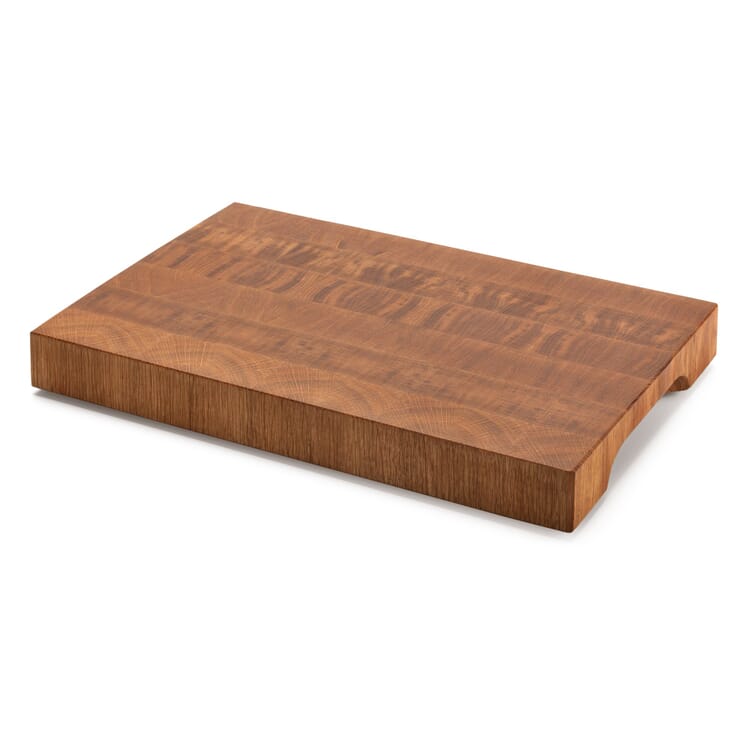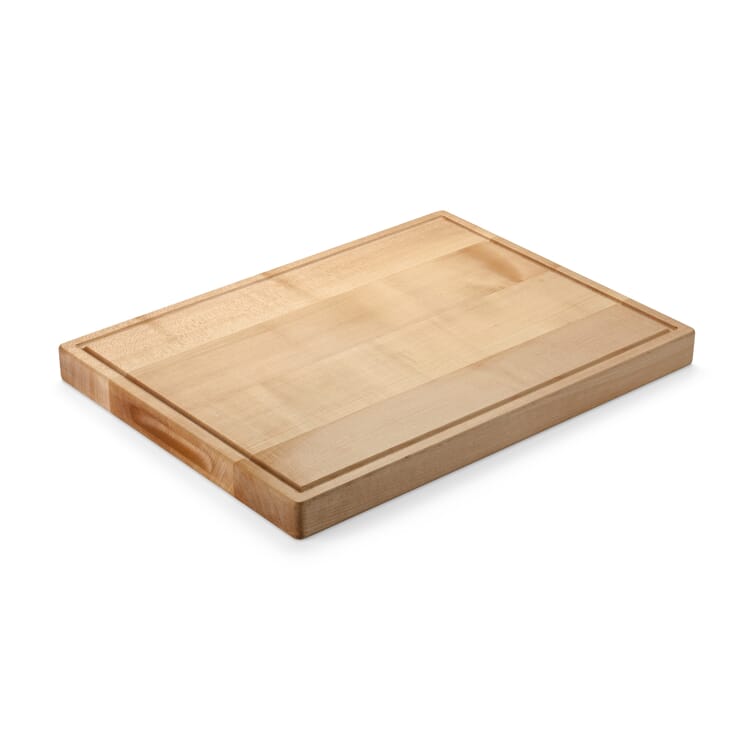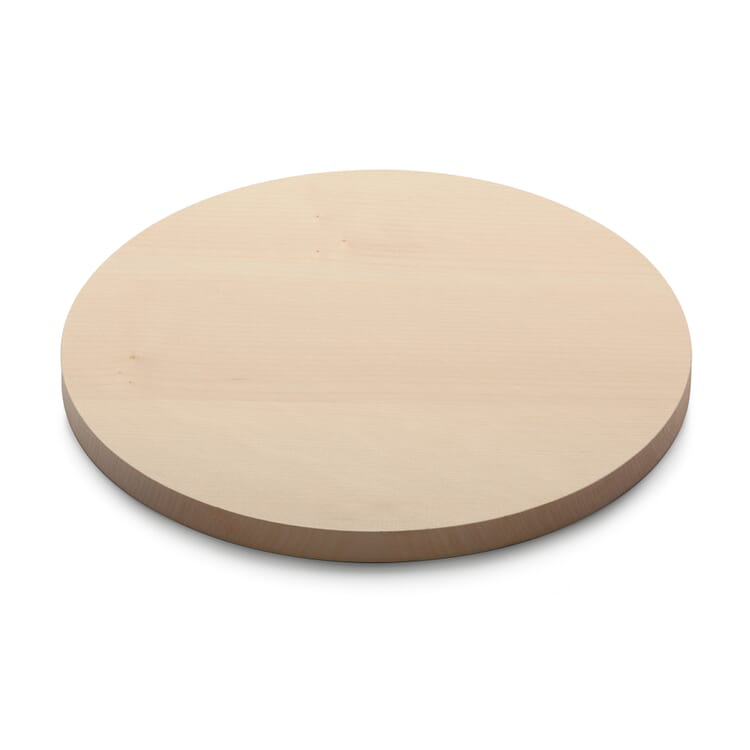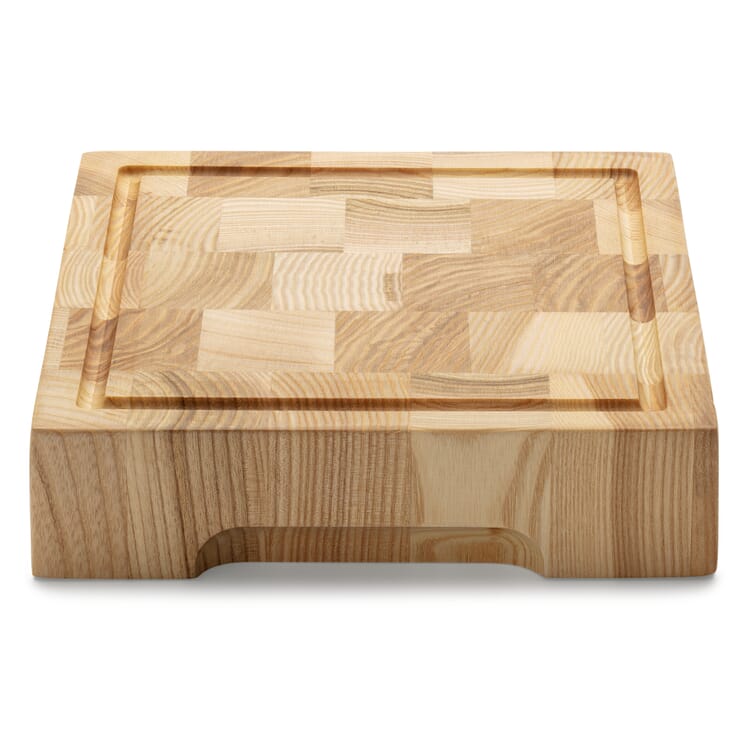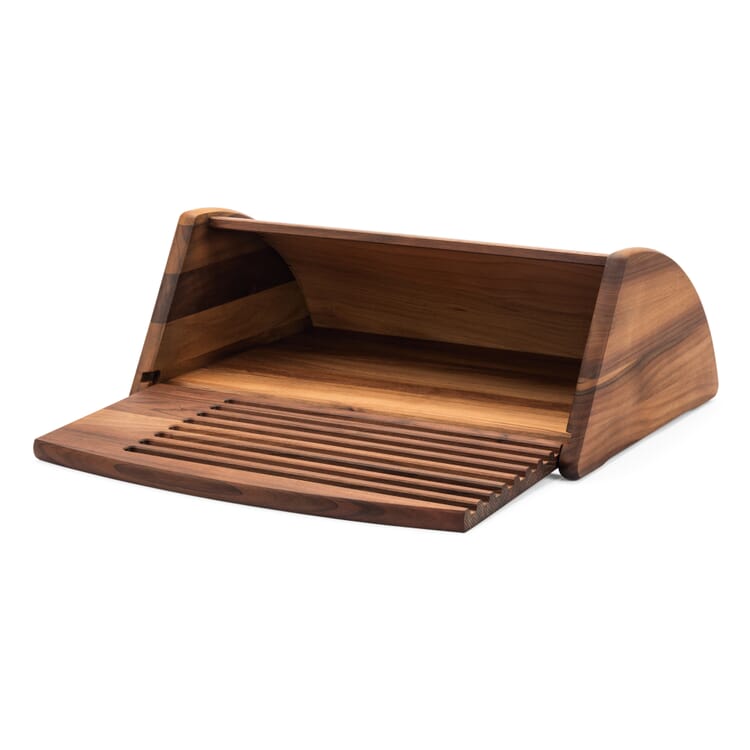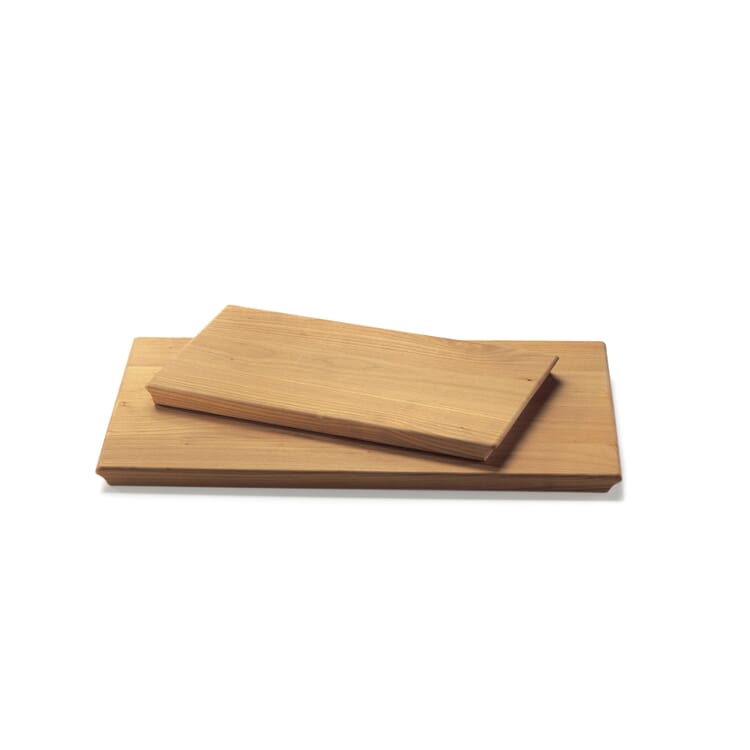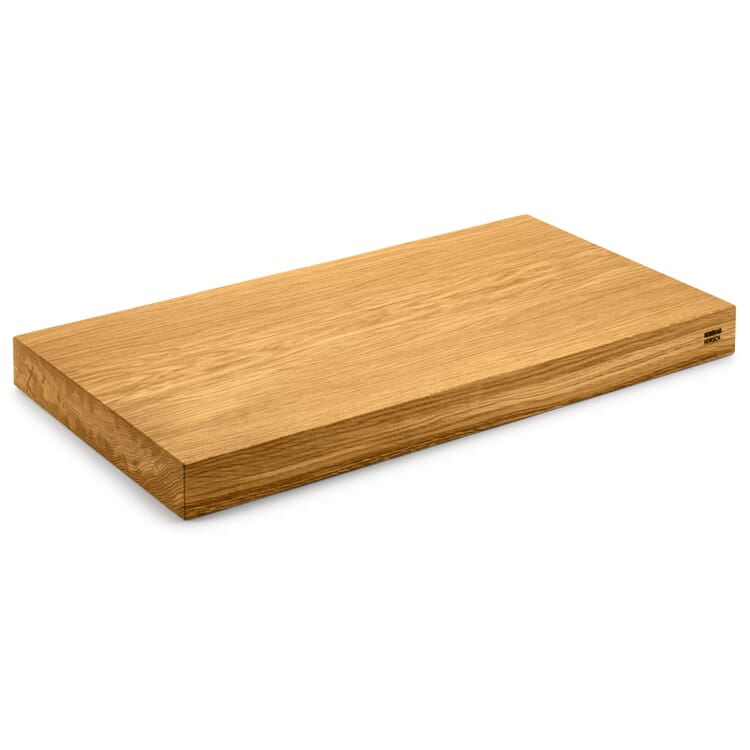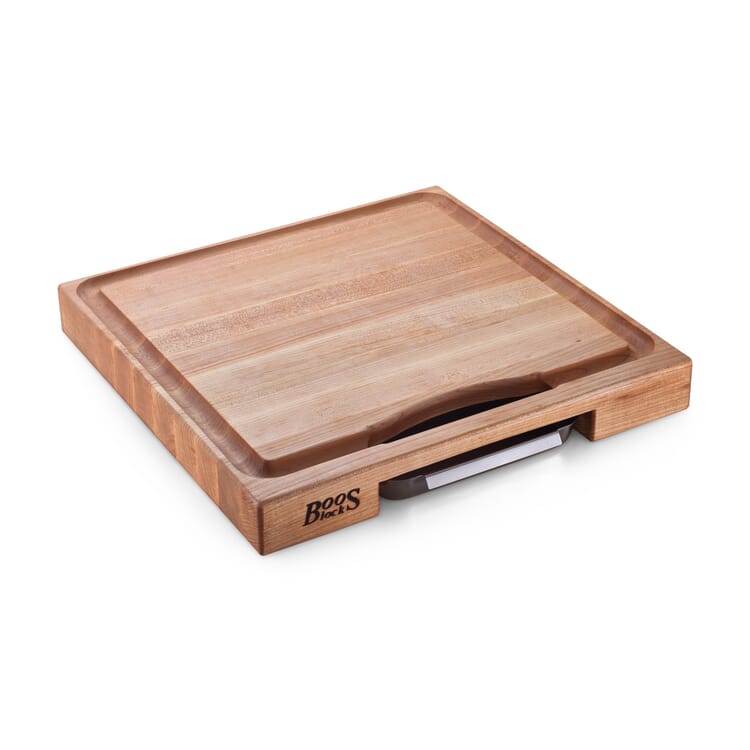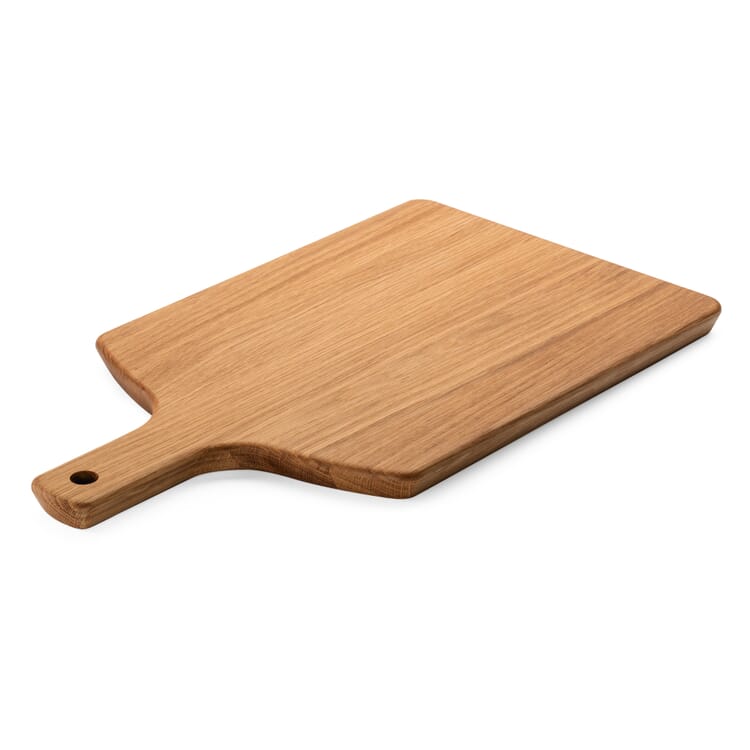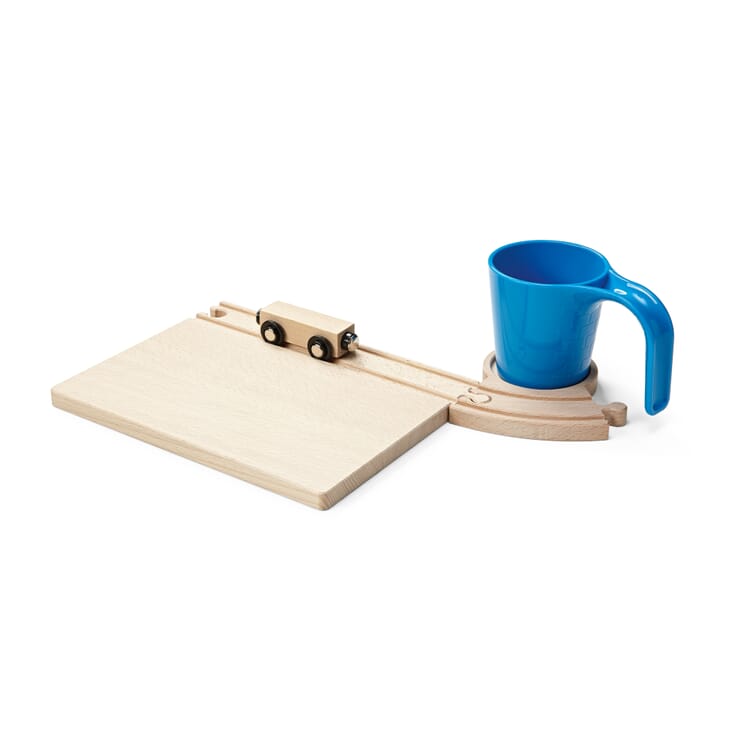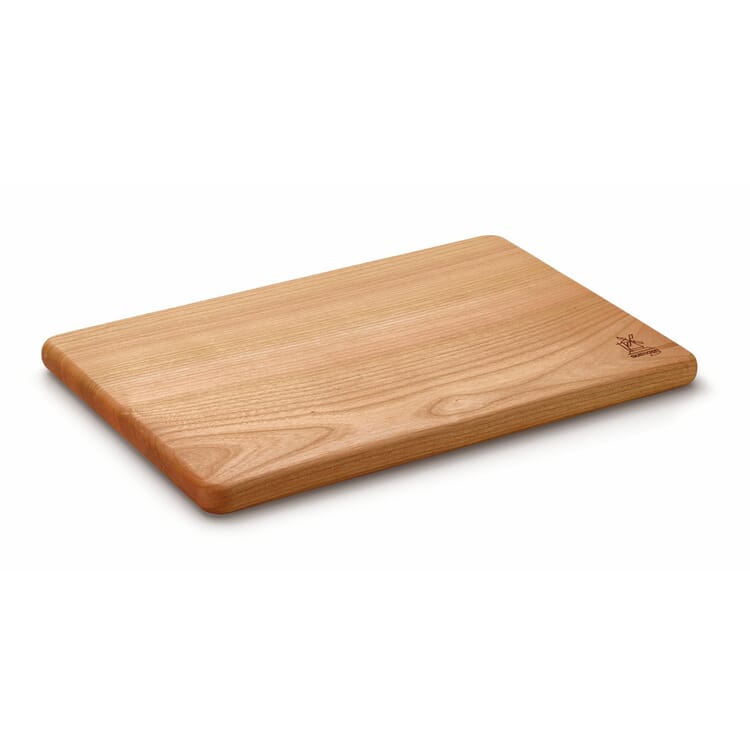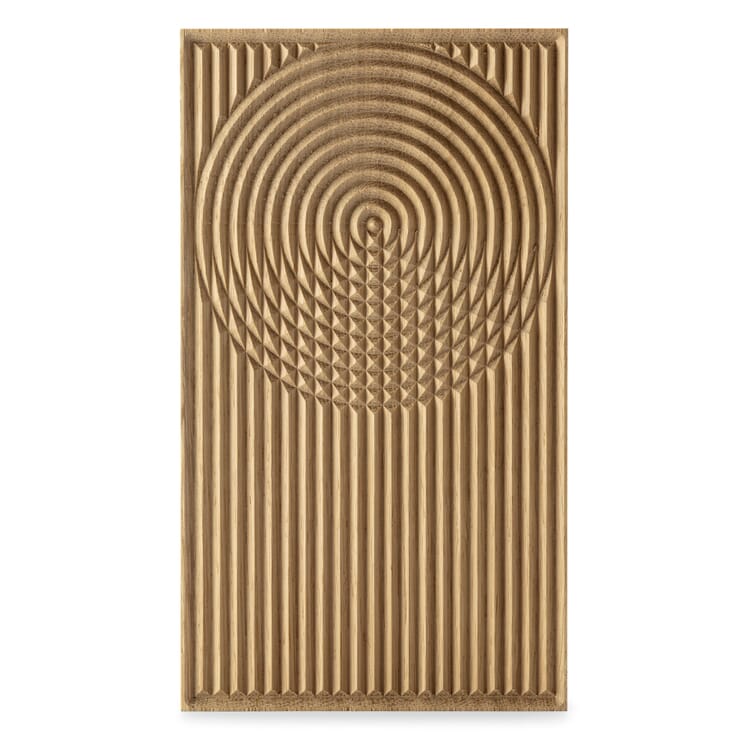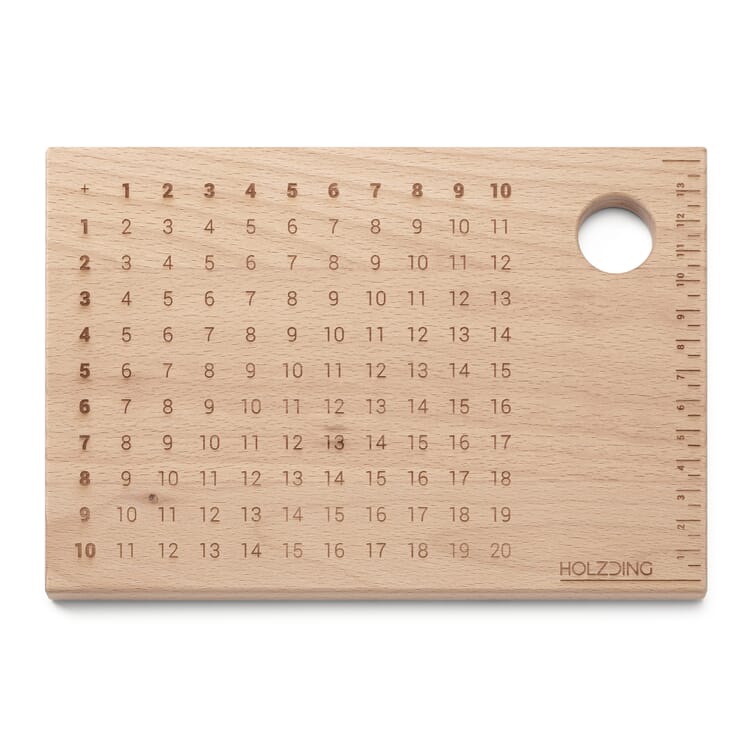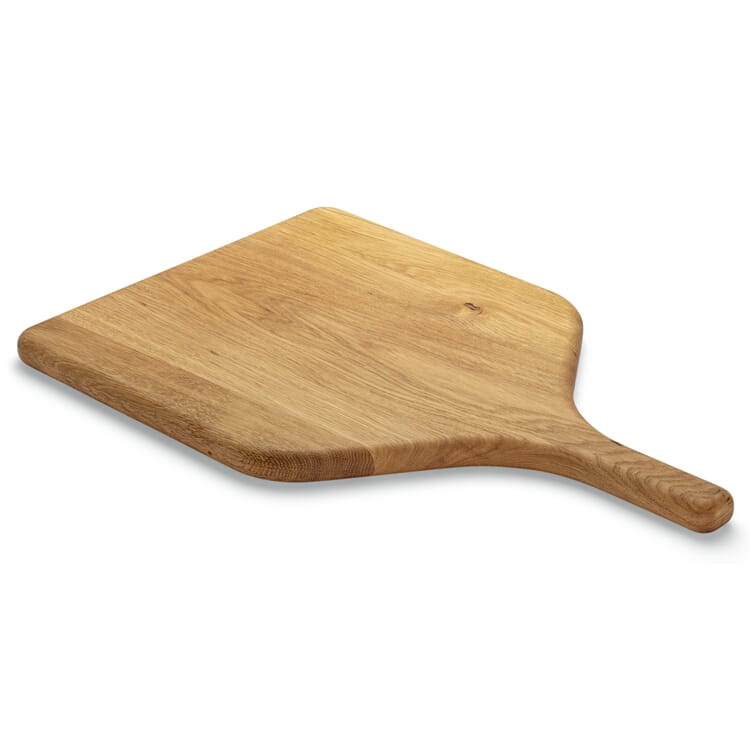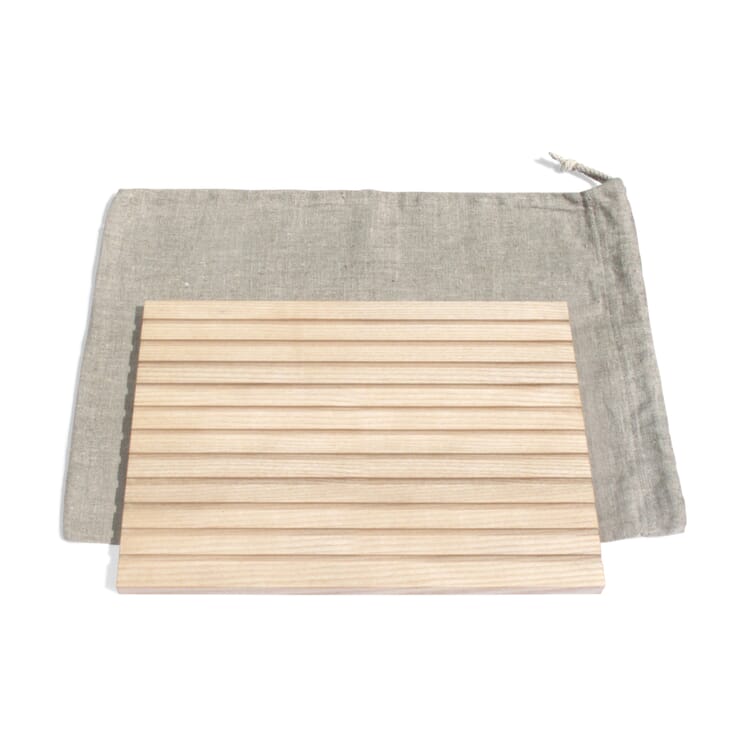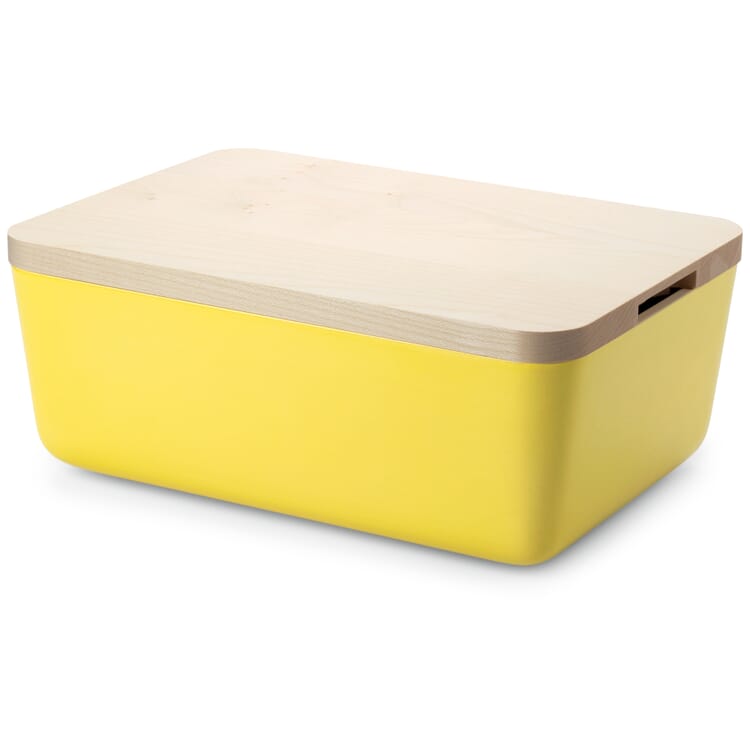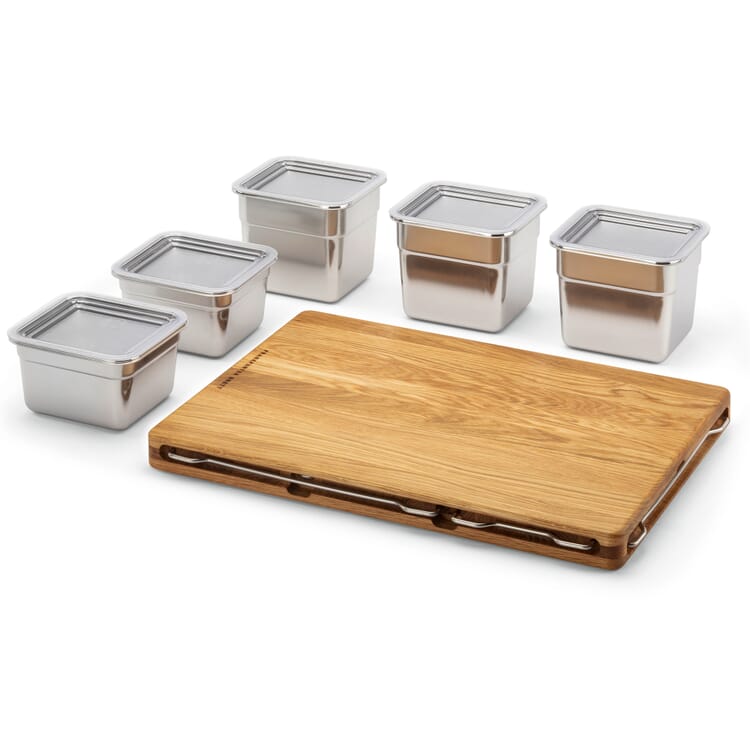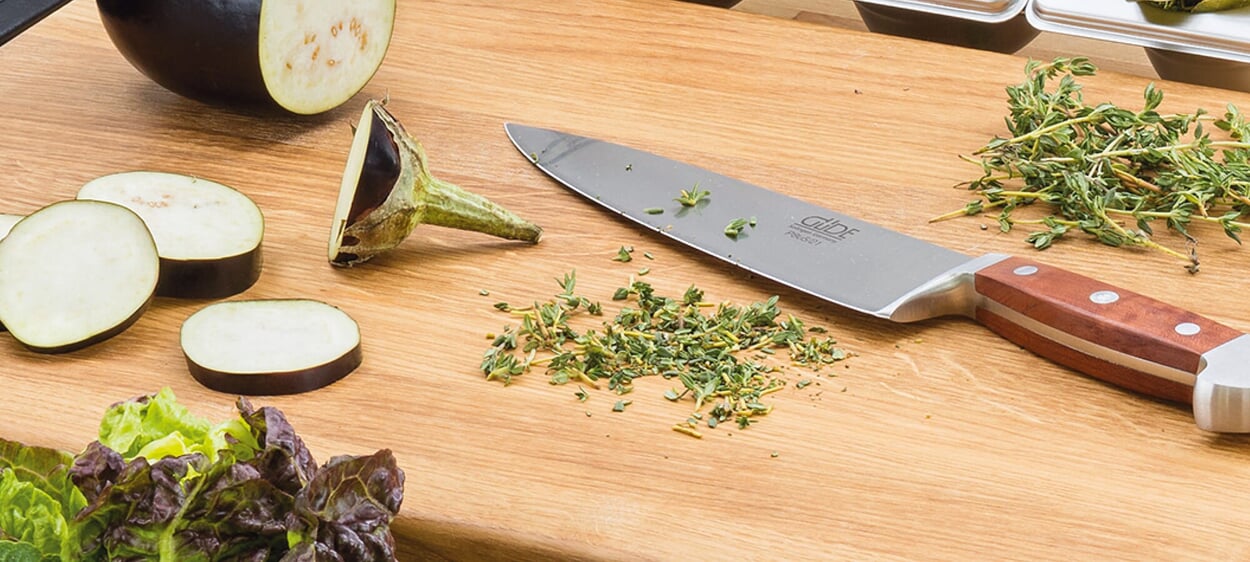Cutting boards
Nothing works in the kitchen without them: cutting, chopping, slicing, filleting, shredding or carving - without chopping boards ... Read more
Guide
Delivered to the knife. Chopping boards that can take a beating
Nothing works in the kitchen without them: cutting, chopping, slicing, filleting, shredding or carving - without chopping boards, even the best knives would be out of a job. There would simply be no reason for what they do. It's high time to give chopping boards the attention they deserve.
The quality and material of the boards on the one hand and their care on the other determine their lifespan, the lasting sharpness of the knives that come into contact with them, the hygiene in your kitchen and the pleasure you get from working with them. So if you think any chopping board will do the trick, you've got another thing coming.
On the wooden path. Or: What makes a good chopping board?
So let's summarize: We are looking for the jack-of-all-trades among chopping boards.
It should
- be gentle on your knives,
- be resistant and durable,
- be easy to clean
- and ideally also be attractive and pleasant to the touch.
The bar is high, but for us it is clear: the best cut is definitely made with wood. But why is that the case?
The knives are sharpened. The clever chopping board gives way
When the going gets tough between the chopping board and the knife, the latter should always come off better. The material of the cutting board must therefore be softer than the material of the knife blade.
Materials such as glass, stone - for example marble - ceramic, metal, but also hard plastic or melamine are therefore disqualified in the first round, despite being easy to clean in some cases. At least if you want to use your chopping board as its name suggests and not just for decorative serving tasks. Candidates that are still in the running at this point are therefore wood and softer plastic.
With consideration for losses. Don't forget the defense
However, it is also a fact that anyone who goes under the knife must not only be able to give way, but also be tough. Not only do sharp knives leave deep cuts in cutting boards that are too soft, which can have a negative impact on cleaning and hygiene, they also remove a lot of material components - and all the more so the longer the boards are used. Such a cutting board firstly breaks down more quickly and secondly contaminates the cut food.
A study published by the American Chemical Society in 2023 therefore identified plastic cutting boards as a serious source of microplastics in food. The test with carrots showed an annual exposure of up to 50 grams of microplastics per person. For comparison: that's about as much as if you were to eat ten credit cards in the same period. And who counts plastic money as one of their favorite foods? For us, plastic is therefore also out of the question, quite apart from its poor ecological footprint - which leaves wood as the only sensible option.
Of course, wood that is too soft is also unsuitable as a cutting board material. Fortunately, the wood market offers an extensive range of suitable robust woods: these cut excellently if you want to make a clear cut without blunting the knife or dismantling the board. And both visually and haptically, wood is unrivaled anyway.
Good wood! Our favorites for cutting boards
Our range offers a whole series of mainly domestic woods to choose from - all with different good properties, to suit your taste:
- Oak wood is one of the most popular woods in Germany and is also considered the most valuable domestic wood species due to its properties. Oak wood is extremely heavy, robust, weather-resistant and durable. Its unlimited resistance to moisture in particular - after all, oak is traditionally used in shipbuilding - makes it ideal for use in the kitchen. Oak darkens noticeably and is characterized by striking grain patterns
- Maple is one of the medium-weight woods, but is extremely elastic and tough and impresses with its high abrasion resistance. Thanks to its fine pores, maple wood is easy to clean. The individual maple species have different colorations. Sycamore maple is particularly light in color, but turns slightly yellowish when oiled. This discoloration is less pronounced in other types of maple. What all maple species have in common is their even coloring and fine grain
- Walnut wood is one of the finest domestic woods due to its limited availability, its aesthetic advantages, its pleasant, smooth feel and its high resilience and is therefore somewhat more expensive. It is similarly hard as oak, but significantly more flexible and tougher. Its characteristic, dark color with the fine, yet lively grain makes it an eye-catcher in the kitchen, where it can also shine with its ease of care
- Cherry is also one of the domestic precious woods. It is moderately hard and yet extremely strong and tough. Thanks to its fine-pored structure, its surface can be finished to be extremely smooth and closed. It is less susceptible to scratches, making cherry wood an extremely durable material for chopping boards. Its warm red-brown color stands out clearly among other woods
- Ash is similarly heavy, robust and hard as oak, but at the same time significantly more elastic and tougher than other domestic wood species and therefore extremely hard-wearing. Its coloring varies within a tree from very light to olive brown at the core, its distinctive grain is rich in structure with clearly visible annual rings
- Beech is only used for breakfast boards in our range. Beech wood is extremely heavy, hard and homogeneous in its density, making it ideal for cutting - however, it works hard and is therefore only suitable for contact with moist food to a limited extent. However, it can easily cope with a hearty snack.
All carved from good wood. But made differently
Not all wooden cutting boards are the same. Of course, they are all excellently crafted and made from high-quality woods, but a look at the surfaces of the cutting boards in the Manufactum range reveals three different manufacturing methods:
1. Long wooden board
The most common form is the longwood board. Here, several long and narrow pieces of wood cut lengthwise to the grain are glued together to form a large surface. Differences in quality result primarily from the type and precision of the gluing and jointing as well as the choice of matching wooden elements - both in terms of color and grain. Careful work and quality awareness ensure that the cutting boards do not warp easily later on. For this reason, some of the boards are even multi-layered with layers arranged crosswise to each other.
2. End grain board
The end-grain board, also known as the end-grain board, is particularly complex to produce and is significantly more robust than the classic long wood variant. End grain is cut across the direction of growth (like tree slices) and - often in the form of small cubes or cuboids - joined together to form a board with the annual rings facing upwards. In addition to the resulting striking appearance, end grain has a whole range of advantages that make it noticeably more resistant than long grain:
- As the fibers of the end grain are perpendicular to the knife blade, the board can absorb significantly more pressure in this dimension, making it a hard board in the truest sense of the word
- This has no disadvantage for the knives, on the contrary: the fibers slide to the side when cutting instead of being severed and thus destroyed.
- When the board is wet-cleaned, the fibres swell due to the moisture, so that small grooves close up again.
- The natural abrasion and thus the contamination of the food being cut is much less due to the flexible fibres.
- The vertical arrangement of the pieces of wood balances out the internal tensile forces, so the cutting board keeps its shape better.
- The natural capillary effect of the open fibres also results in a significantly higher suction capacity when handling moist food.
3. Solid wood board
The solid wood cutting board is a rare, but extremely valuable form of cutting board due to the materials required. Cut from a solid piece and elaborately finished to make it more resistant to warping, such a piece of craftsmanship radiates an individuality that other chopping boards lack.
Nipped in the bud. Good hygiene thanks to antibacterial effect
After wood had been the dominant material in the kitchen for centuries, the introduction of plastics led to the widespread belief that plastic chopping boards were more hygienic than wooden chopping boards. The fact that only plastic boards are used in German professional kitchens also contributed to this opinion.
However, a number of serious studies have now shown that wood has an antibacterial effect due to the natural tannins it contains and is even superior to plastic equivalents in terms of hygiene when used, cleaned and cared for properly:
- During each cutting process, so-called tannins are released in the wood, which effectively combat the growth of germs down to the deeper layers of the board.
- On plastic boards, on the other hand, germs can multiply uncontrollably in a very short time and settle in cuts and grooves, to which artificial materials are also much more susceptible.
- Oak wood has the highest proportion of tannins and therefore has a particularly good antibacterial effect.
- Thanks to its highly hygroscopic effect - moisture is attracted and trapped - wood also deprives bacteria of their basis for life.
Unfortunately, European hygiene regulations do not yet take these findings into account, despite recommendations to the contrary. In contrast, maple cutting boards are explicitly approved for use in the catering industry in the USA. We can take this as an example in our kitchens at home with a clear conscience.
Cleanly done. Hygiene when handling wooden chopping boards
It actually goes without saying: If you clean your chopping boards thoroughly, you are doing a clean job. There are just a few things to bear in mind so as not to jeopardize the longevity of wooden chopping boards:
- The most important rule is: never clean your wooden chopping boards in the dishwasher, but always by hand. Rinsing with water in the dishwasher causes warping and cracking
- Never leave the wooden chopping board in water
- Instead, clean your chopping board as soon as possible after use, especially after processing animal products such as raw meat
- Use hot water, just hot enough to withstand, and a little washing-up liquid. We probably don't need to mention that you should use clean sponges and dishcloths
- Dry the chopping board thoroughly afterwards and leave it to dry, preferably standing upright and, above all, outside the cupboard or drawer. Only when it is completely dry should it be put away
- Always moisten both sides of the chopping board when cleaning so that it does not warp.
If vegetables such as beet or red cabbage, turmeric or pumpkin have stained your chopping boards, or if fish, onions or garlic have affected their smell, the following household remedies are suitable for tackling the annoying pigments and odors:
- Baking soda or baking powder
- Salt
- Lemon juice
- Vinegar
It is best to use a mixture of a liquid and a dry ingredient. This gives you a paste-like consistency with a rubbing effect; the paste is easy to spread and can also penetrate grooves. Lemon juice can be combined with anything, but you should avoid mixing vinegar and salt. Spread the paste generously on your discolored or strong-smelling cutting board, let it soak in well and rinse it off again while brushing or wiping along the grain. Lemon and salt should work best against discoloration. Vinegar and baking soda, on the other hand, are most effective against odors, but we do not recommend rubbing a stained board with lemon juice and leaving it in the sun. Although sunlight is extremely effective in combating stains, it also promotes the ageing of the wood enormously. Basically, your wooden chopping board will thank you if you keep it away from direct sunlight and heat sources. You should also avoid prolonged contact between wood with a particularly high tannic acid content and carbon steel knives, as the combination of tannins, iron and moisture can cause black-bluish discolouration. Therefore, never leave a carbon steel knife on a damp wooden board - not least for the sake of edge retention.
Care and maintenance. Even a chopping board needs love
You probably know this: if your skin is constantly exposed to soap and water, it soon becomes cracked and dry. A wooden chopping board behaves in the same way. In addition to regular cleaning, it therefore needs some rich care from time to time. While you may resort to creams and tinctures, wood is happy to be rubbed with cooking oil. Be sure to choose hardening oils that form a protective film and do not go rancid. Food-safe linseed oil and walnut oil are suitable here. However, the latter leaves a characteristic note and is therefore a matter of taste in the truest sense of the word.
This is how you proceed if you want to oil your wooden cutting board:
- Once you have thoroughly cleaned and dried the board, apply the oil evenly with a soft cotton cloth. Make sure you don't miss any spots, but don't be too generous either, as this will delay drying. If the board is very dry, repeat the process with a second or third thin layer after the first has been absorbed
- Leave the oil to dry at least overnight, preferably for up to two days, to allow it to harden properly
- If some excess oil remains on the board, remove it afterwards with a clean, dry cloth
- It is advisable to repeat this process every few months. When it makes sense to re-oil depends largely on the use of the cutting board, the type of wood and environmental conditions such as humidity.
And finally. A few more answers ...
Who would have thought that so much could be said about chopping boards - and yet there are still questions left? No problem, we'll manage that too.

